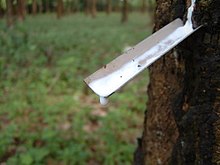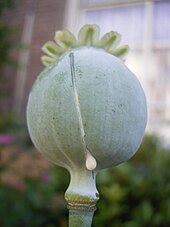Latex
This article may be too technical for most readers to understand. (April 2020) |
Latex is an emulsion (stable dispersion) of polymer microparticles in water.[1] Latexes are found in nature, but synthetic latexes are common as well.
In nature, latex is found as a
The word latex is also used to refer to natural latex

Biology
Articulated laticifers
The
Non-articulated laticifers
In the
The laticiferous system is present in all parts of the mature plant, including roots, stems, leaves, and sometimes the fruits. It is particularly noticeable in the cortical tissues. Latex is usually exuded as a white liquid, but is some cases it can be clear, yellow or red, as in Cannabaceae.[2]
Productive species
Latex is produced by 20,000
Defense function

Latex functions to protect the plant from herbivores. The idea was first proposed in 1887 by Joseph F. James, who noted that latex of milkweed
carries with it at the same time such disagreeable properties that it becomes a better protection to the plant from enemies than all the thorns, prickles, or hairs that could be provided. In this plant, so copious and so distasteful has the sap become that it serves a most important purpose in its economy.[8]
Evidence showing this defense function include the finding that
Other evidence is that latex contains 50–1000× higher concentrations of defense substances than other plant tissues. These toxins include ones that are also toxic to the plant and consist of a diverse range of chemicals that are either poisonous or "antinutritive."
Latex is actively moved to the area of injury; in the case of Cryptostegia grandiflora, latex more than 70 cm from the site of injury is mobilized.[2] The large hydrostatic pressure in this vine enables an extremely high flow rate of latex. In a 1935 report the botanist Catherine M. Bangham observed that "piercing the fruit stalk of Cryptostegia grandiflora produced a jet of latex over a meter long, and maintained [this jet] for several seconds."[9]
The clotting property of latex is functional in this defense since it limits wastage and its stickiness traps insects and their mouthparts.[2]
While there exist other explanations for the existence of latex including storage and movement of plant nutrients, waste, and maintenance of water balance that "[e]ssentially none of these functions remain credible and none have any empirical support".[2]
Applications

The latex of many species can be processed to produce many materials.
- gutta percha latex contain an inelastic polymer related to rubber.[citation needed]
- Chicle and jelutong tree latex was used in chewing gum.[10]
Personal and healthcare products
Natural rubber is the most important product obtained from latex; more than 12,000 plant species yield latex containing rubber, though in the vast majority of those species the rubber is not suitable for commercial use.[11] This latex is used to make many other products including mattresses,[12][13] gloves, swim caps, condoms, catheters and balloons.[citation needed]
Opium and opiates
Dried latex from the
Clothing
Latex is used in many types of clothing. Worn on the body (or applied directly by painting), it tends to be skin-tight, producing a "second skin" effect.[14]
Industrial and biological applications of synthetic latexes
Synthetic latexes are used in
Allergic reactions
Some people only experience a
Others have a serious
About half of people with spina bifida are also allergic to natural latex rubber, as well as people who have had multiple surgeries, and people who have had prolonged exposure to natural latex.[18]
Microbial degradation
Several species of the
See also
References
- S2CID 96720306.
- ^ .
- S2CID 40056337.
- ^ Harper, Douglas. "latex". Online Etymology Dictionary.
- Perseus Project.
- ^ "Taraxacum kok-saghyz". Pfaf.org. Archived from the original on 2014-03-20. Retrieved 2013-03-21.
- S2CID 44594197.
- JSTOR 2451222.
- ISBN 978-0124314269.)
{{cite book}}: CS1 maint: location (link - ISBN 978-0-8165-2821-9.
- OCLC 28534889.
- ^ Liman, Stacy (26 June 2020). "Latex Mattresses: The Best Latex Mattress Guide". Retrieved 17 August 2020.
- ^ Yurkovich, Dror. "Dunlop latex vs. Talalay latex". Getha. Archived from the original on 2021-04-13. Retrieved 2021-04-22.
- OCLC 1262726608.)
{{cite book}}: CS1 maint: location missing publisher (link) CS1 maint: others (link - ISSN 0269-4727.
- ^ "Latex Allergy | Causes, Symptoms & Treatment". ACAAI Public Website. Retrieved 2019-03-24.
- ISBN 9781859573815. Retrieved 8 May 2018 – via Google Books.
- ^ "Latex allergy - Symptoms and causes". mayoclinic.com. Archived from the original on 7 October 2013. Retrieved 8 May 2018.
- PMID 10966376.
- PMID 15932971.
External links
 Media related to latex at Wikimedia Commons
Media related to latex at Wikimedia Commons
